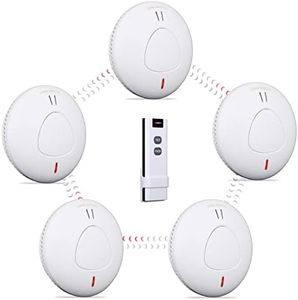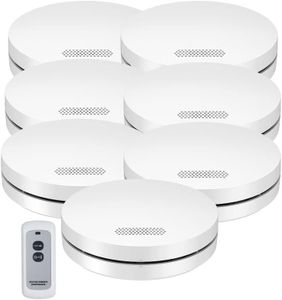We Use CookiesWe use cookies to enhance the security, performance,
functionality and for analytical and promotional activities. By continuing to browse this site you
are agreeing to our privacy policy
5 Best Wifi Smoke Alarms
From leading brands and best sellers available on the web.By clicking on a link to a third party's website, log data is shared with that third party.
Buying Guide for the Best Wifi Smoke Alarms
Choosing a WiFi smoke alarm is about ensuring your home or space is protected from fire hazards with the added convenience of smart technology. These alarms can send alerts to your phone, keep you informed even when you're away, and often offer additional features like integration with other smart home systems. Focusing on the most important features will help you find an alarm that provides both safety and ease of use.ConnectivityConnectivity refers to how the smoke alarm links to your home WiFi and communicates with your smartphone or other devices. This is important because reliable connectivity ensures you'll receive instant notifications about smoke or fire, wherever you are. Some alarms only connect directly via WiFi, while others may support both WiFi and additional options like Bluetooth or Zigbee for wider smart home compatibility. For most users, strong WiFi support is enough, but if you already use a smart home system, look for alarms that can connect with those platforms for smoother integration.
Power SourceThe power source determines how the alarm is powered, usually through batteries or hard-wiring into your electrical system. Battery-powered models are easy to install and ideal for renters or situations where wiring isn’t practical, but require regular battery changes or periodic charging. Hard-wired alarms are more permanent and may have battery backup for power outages. Consider your willingness to change or charge batteries versus the convenience of a set-and-forget system when choosing the right type for you.
Sensor TypeSmoke alarms use different types of sensors: ionization, photoelectric, or a combination of both. Ionization sensors are quicker at detecting fast, flaming fires, while photoelectric sensors are better at sensing slow, smoldering fires. Some alarms feature dual sensors to cover both types of fires for maximum safety. If you want thorough protection for all fire scenarios, look for dual-sensor models. Otherwise, choose the sensor that best fits the risks typical for your environment (for example, kitchens may benefit more from photoelectric sensors to reduce false alarms from cooking smoke).
Notification FeaturesNotification features refer to how the smoke alarm communicates its alerts—through loud sounds, smartphone notifications, voice alerts, or even integration with other smart devices. A loud alarm is always necessary, but smartphone or remote notifications are critical for knowing about problems even when you’re not home. Some alarms let you silence false alarms through your phone, or send alerts to multiple people. Consider what will keep you best informed and give you the most peace of mind, especially if you travel or leave pets at home alone.
InterconnectivityInterconnectivity means the ability of one alarm to trigger others in your home, creating a networked response so every area is alerted, even if smoke is detected far from you. This is important for larger homes or multi-story buildings where you might not hear a distant alarm. Alarms can connect wirelessly or through wires; ensure the option you pick works with your existing setup. For maximum safety, especially in family homes, interconnectivity is a valuable feature.
App UsabilityApp usability covers how easy and intuitive the companion app is to set up and use. This is important because all WiFi-enabled alerts and additional features are accessible through the app. Some apps offer clear setup guides, helpful testing functions, status checks, and maintenance reminders, while others might be less user-friendly or full of confusing settings. Before choosing, consider how comfortable you feel with apps and look for smoke alarms with accessible and highly-rated user experiences.
Smart Home IntegrationSmart home integration is about whether and how your smoke alarm can communicate with other smart devices, like voice assistants or automation systems. This is useful for automating responses (like turning on lights in case of an alarm) or simply for monitoring everything within one ecosystem. If you already own smart home devices or plan to expand, look for alarms compatible with platforms like Alexa, Google Home, or Apple HomeKit. If you don’t use these systems, you can focus on standalone models.





